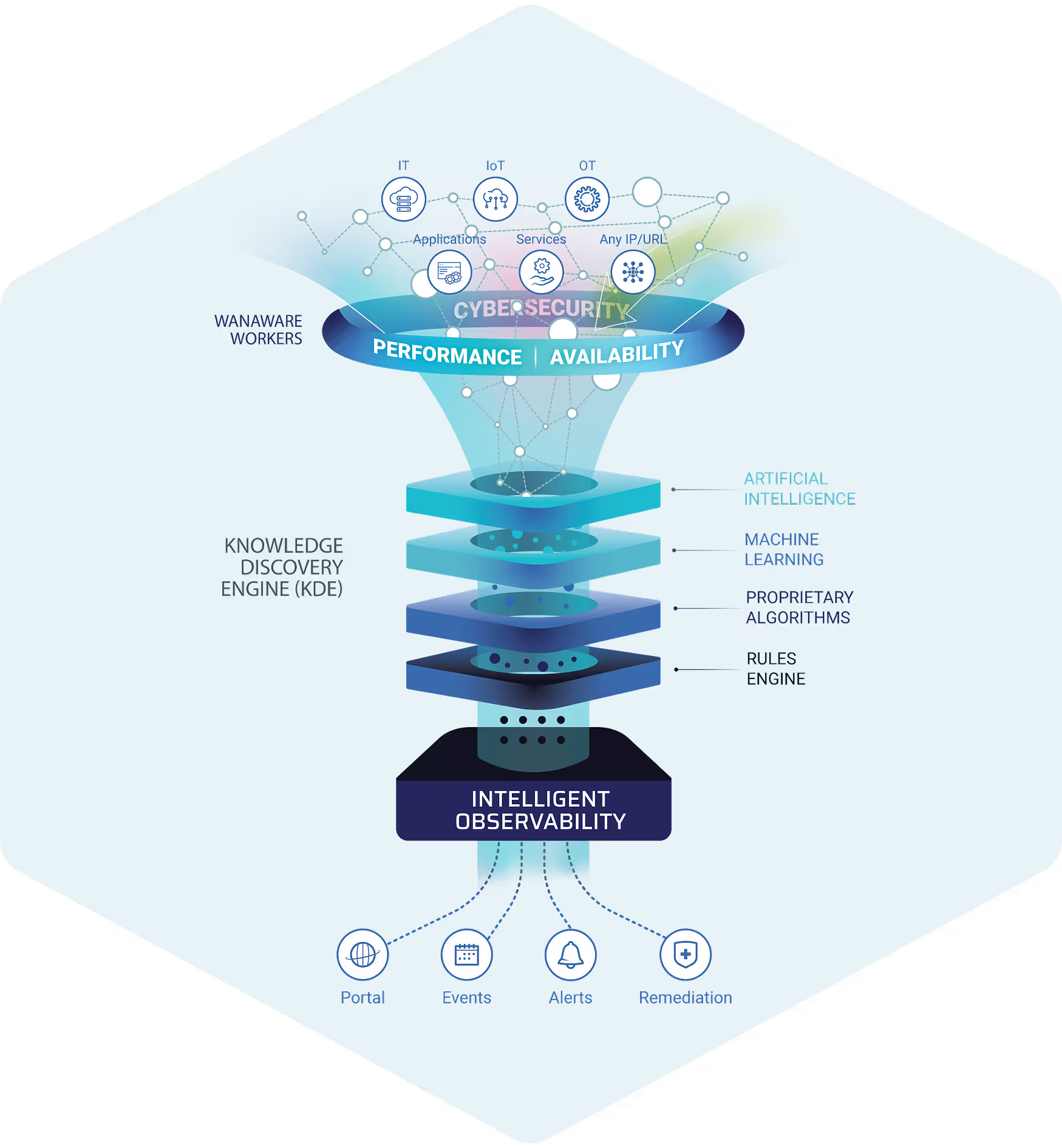From Noise to Action:
Inside the KnowledgE
Discovery Engine
How WanAware’s Knowledge Discovery Engine Helps You Focus, Respond, and Win
You don’t have a monitoring problem.
You have a signal problem.
Today’s infrastructure environments generate mountains of data—telemetry from dozens of tools, alerts from every layer of the stack, and signals from systems you don’t even own (third-party APIs, cloud regions, SaaS dependencies). But more data hasn’t made us smarter. It’s made us slower.
The real problem isn’t visibility. It’s discernment.
And that’s what WanAware’s Knowledge Discovery Engine (KDE) delivers.

What Is the KDE?
At its core, the KDE is a real-time decision layer that sits between your telemetry signals and your team. It doesn’t replace your monitoring stack—it makes it more useful.
Imagine a system that takes in raw, conflicting, high-volume data and gives you:
- A clear sense of what’s actually broken
- An understanding of what else is affected
- A recommendation (or automation) for what to do next
That’s what KDE does. It’s your noise-to-action regulator.


KDE does four essential things
Ingest Broadly, Across All Layers
KDE pulls from wherever your assets live: performance, availability and security signals from internal and even external systems (like DNS providers or cloud APIs). The goal isn’t to compete with tools like Datadog or Splunk—it’s to synthesize what they report.
Score and Sort by Actionability
KDE applies a combination of learned patterns (ML), human logic (rules), and confidence modeling (AI) to decide whether an issue is:
- Safe to ignore
- Worth surfacing
- Or urgent enough to trigger automation
This is where KDE shines: instead of giving you a flood of alerts, it decides what’s worth your time—with evidence.
Correlate Data Using Context, Not Just Rules
Instead of treating every signal as isolated, KDE references a knowledge graph in the background—connecting which services rely on which others, where traffic flows, what’s public-facing, and how components behave over time. This graph allows KDE to distinguish a real issue from an expected anomaly (like a noisy neighbor causing CPU spikes that don’t matter).
Score and Sort by Actionability
KDE applies a combination of learned patterns (ML), human logic (rules), and confidence modeling (AI) to decide whether an issue is:Safe to ignoreWorth surfacingOr urgent enough to trigger automation This is where KDE shines: instead of giving you a flood of alerts, it decides what’s worth your time—with evidence.
KDE applies a combination of learned patterns (ML), human logic (rules), and confidence modeling (AI) to decide whether an issue is:
- Safe to ignore
- Worth surfacing
- Or urgent enough to trigger automation
This is where KDE shines: instead of giving you a flood of alerts, it decides what’s worth your time—with evidence.
Correlate Data Using Context, Not Just Rules
Instead of treating every signal as isolated, KDE references a knowledge graph in the background—connecting which services rely on which others, where traffic flows, what’s public-facing, and how components behave over time. This graph allows KDE to distinguish a real issue from an expected anomaly (like a noisy neighbor causing CPU spikes that don’t matter).
Trigger Action or Escalate With Full Context
If KDE determines an issue can be safely resolved (like rebooting a stuck process), it automates it. If not, it sends a complete, pre-digested report to the right team: what’s happening, what changed, what’s connected, and what the system believes the next best step is.

Why This Matters to You
Alert Fatigue, Solved
Stop drowning in pings. KDE reduces noise by up to 90%, letting your team focus on real problems—not dashboard archaeology.
Fewer Escalations, Fewer Mistakes
By automatically filtering noise and escalating only when needed, KDE improves reliability and reduces the chance of missing critical signals or acting on the wrong ones.
Map Everything
With pre-analyzed impact and clear action paths, issues get resolved in minutes—not hours of Slack threads and hunches.
Performance Without Guesswork
Want to understand how a change to one service affects five others? KDE already mapped it—and will warn you before that ripple turns into a wave.
Think of It Like This
Monitoring tells you something happened.
KDE tells you whether it matters, what else it touches, and what to do.
TL;DR
The Knowledge Discovery Engine is your infrastructure’s intelligent immune system—not just detecting anomalies, but deciding which ones deserve attention, how they connect to the broader system, and what to do next.
It’s not another data layer.
It’s the translation layer between telemetry and intelligent action.
That’s what makes it different. And that’s why teams using KDE stop reacting—and start outperforming.

Ready to Unlock Your Data’s Potential?
Ready to transform your data into actionable insights? Contact us now to schedule a demo or speak with our experts and see how WanAware’s KDE can empower your business





.jpg)
.png)
